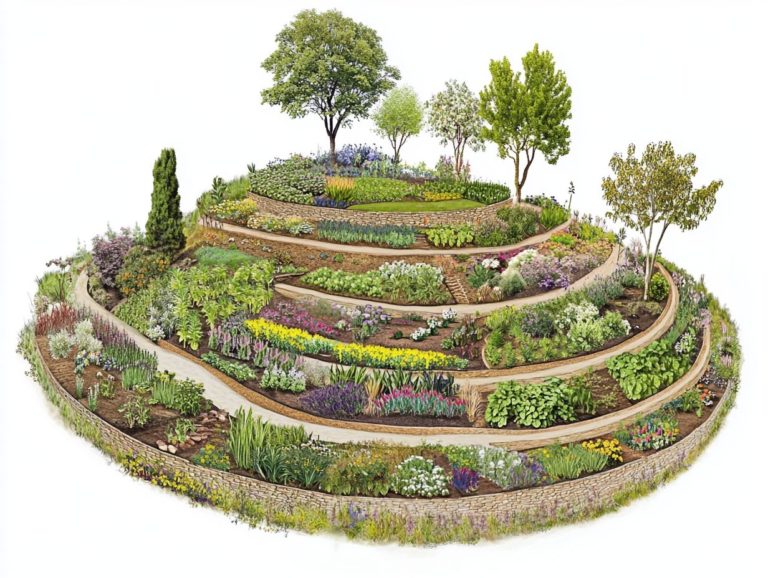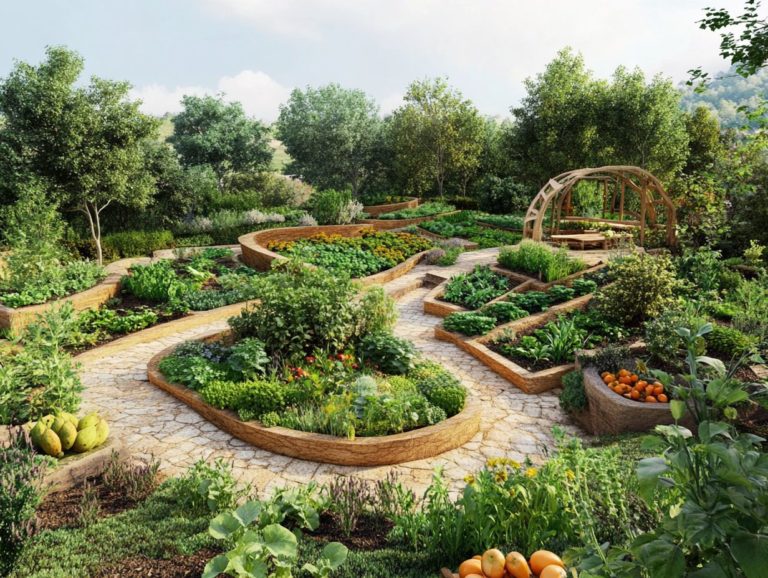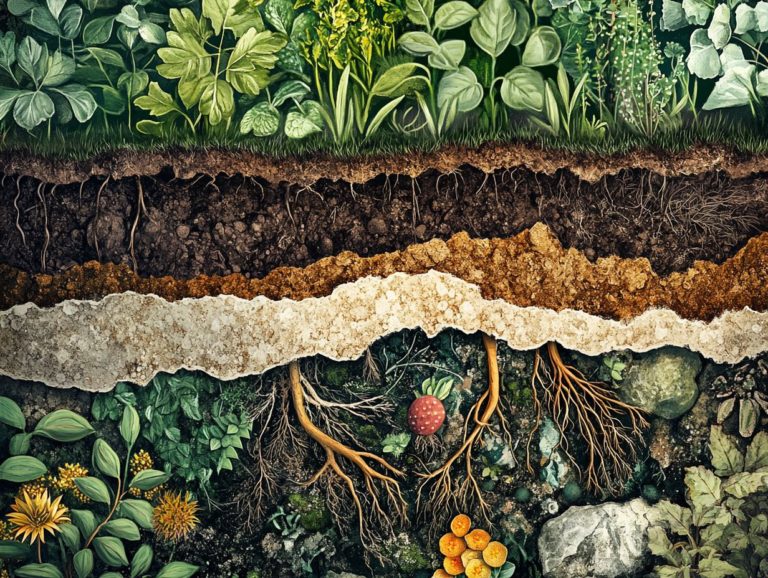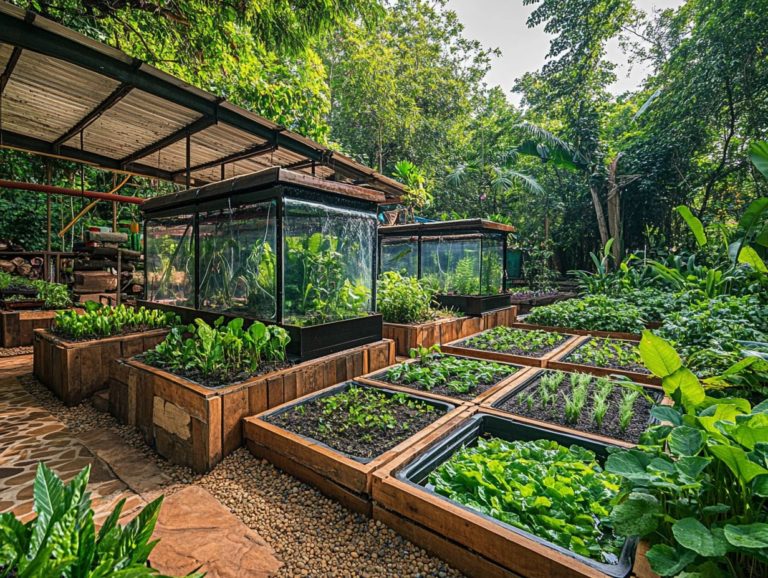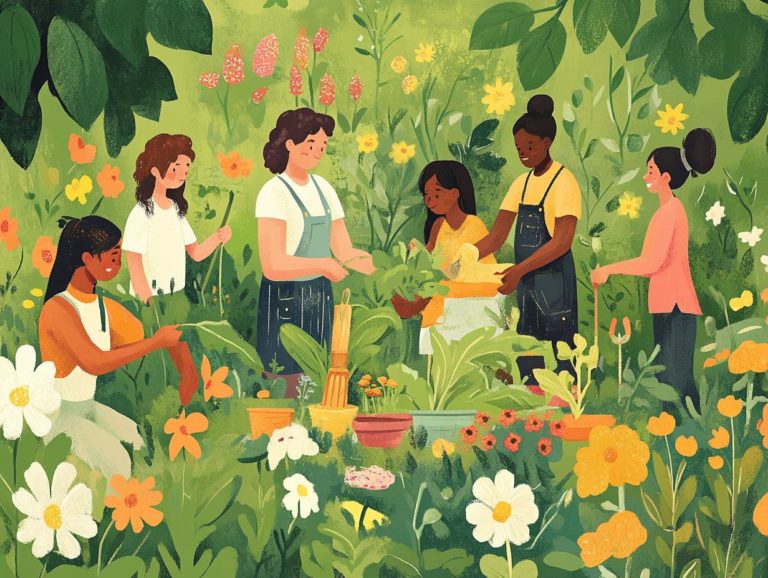Permaculture Design: Importance of Soil Management
Permaculture design presents a transformative approach to sustainable living that champions harmony with nature, placing a strong emphasis on the often-overlooked significance of soil management.
Join us as we explore the exciting world of permaculture! You ll find that healthy soil serves as the bedrock of vibrant ecosystems and flourishing gardens. This article highlights the pivotal role of soil and presents various strategies to enhance its vitality.
As you explore practical applications, you ll uncover the manifold benefits of permaculture for both the environment and agriculture while also addressing the common challenges that may arise. Immerse yourself in this journey to cultivate a deeper appreciation for the vital role soil plays in the art of permaculture design.
Contents
- Key Takeaways:
- The Basics of Permaculture Design
- The Role of Soil in Permaculture
- Methods for Improving Soil Health
- How to Implement Permaculture Design in Soil Management
- Benefits of Permaculture Design for Soil
- Tackling Soil Management Challenges in Permaculture
- Frequently Asked Questions
- What is permaculture design and why is it important?
- How does permaculture design relate to soil management?
- What are some benefits of proper soil management in permaculture design?
- How can I improve the quality of my soil in a permaculture system?
- Why is it important to consider the type of soil in a permaculture design?
- How does permaculture design promote sustainable soil management?
Key Takeaways:
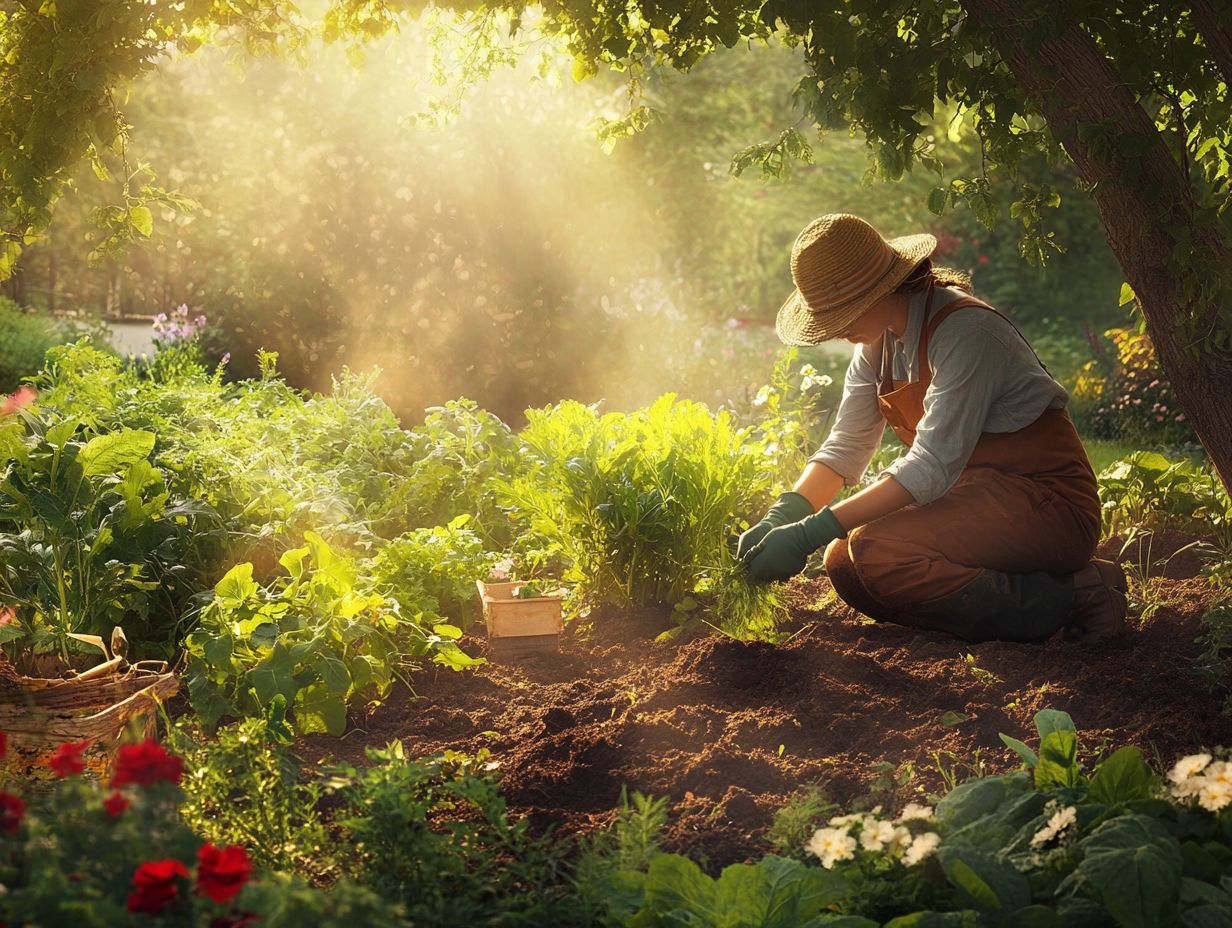
- Permaculture design emphasizes the importance of soil management for sustainable and regenerative practices.
- Methods such as composting can greatly improve soil health and fertility.
- Applying permaculture principles can lead to numerous benefits for the environment and agriculture.
The Basics of Permaculture Design
Permaculture design represents a new way to sustainable agriculture, emphasizing the creation of able to support itself and resilient ecological systems. By seamlessly integrating natural ecosystems with agricultural practices, you can enhance soil health and promote biodiversity.
This holistic method, championed by experts like Geoff Lawton, invites you to embrace ecological practices that manage resources efficiently. In doing so, you foster not only environmental stewardship but also a sense of community engagement that enriches both your land and those who share it.
What is Permaculture?
Permaculture is more than just a gardening technique; it’s a design philosophy aimed at creating sustainable and self-regulating agricultural systems inspired by the beauty of natural ecosystems.
By integrating various elements like plants, animals, water, and soil into a cohesive framework, you can cultivate food while simultaneously nurturing biodiversity and enhancing ecosystem health. The key principles of permaculture observation, diversity, and energy efficiency work together to minimize waste and maximize productivity.
This holistic approach builds resilience against pests and environmental stresses, ensuring the long-term viability of your agricultural practices. Ultimately, the goal is to cultivate not just food, but vibrant, thriving ecosystems that coexist harmoniously with human activity.
The Role of Soil in Permaculture
The role of soil in permaculture is absolutely essential, as healthy soil forms the bedrock of thriving ecosystems and sustainable agricultural practices.
In the world of permaculture, soil health transcends mere fertility; it also includes vital elements like soil structure, biodiversity, and carbon sequestration (the process of capturing and storing carbon dioxide to combat climate change). By effectively managing soil, you can enhance organic matter, nurture soil organisms, and foster nutrient cycling.
This comprehensive approach ultimately leads to improved farming systems and a harmonious ecological balance.
Understanding the Importance of Soil Management
Understanding the significance of soil management is crucial for you to achieve sustainable agriculture and ensure long-term soil fertility. This practice is crucial for building lively ecosystems, helping you maintain nutrient balance and structure in the ground.
Utilizing effective techniques like crop rotation can elevate biodiversity, preventing soil depletion and disrupting pest cycles. Meanwhile, cover cropping acts as a protective shield for the soil, guarding against erosion and retaining moisture, thus fostering a more resilient agricultural system.
Regular soil tests are critical; they provide you with essential insights into nutrient levels and pH balance, guiding your decisions on appropriate amendments. By placing a premium on soil conservation, you can cultivate an environment that nurtures both crop health and ecological balance, an absolute necessity in the quest for resource-efficient farming.
Methods for Improving Soil Health

You have a wealth of effective methods at your disposal for improving soil health. This is essential for sustaining agricultural practices and bolstering ecosystem resilience.
Techniques like composting and cover cropping are pivotal in enriching soil biodiversity.
They also enhance nutrient cycling.
By prioritizing improving soil health and employing these sustainable strategies, you can ensure that your soil remains fertile and productive for years to come.
Composting and Other Techniques
Composting stands out as one of the most effective techniques for enhancing soil health. It effortlessly infuses organic matter and essential nutrients back into the earth.
This natural process transforms organic waste think kitchen scraps and yard debris into nutrient-rich humus through decomposition.
As you incorporate this rich compost into your soil, you’ll notice improvements in its texture and structure, enhancing aeration and drainage.
You’ll also see a marked increase in its water retention capabilities. This process really boosts microbial activity, fostering the availability of vital nutrients like nitrogen, phosphorus, and potassium.
But don t stop at composting! Embracing practices like cover cropping and crop rotation can further elevate soil fertility, ensuring a balanced ecosystem that sustains agricultural productivity while reducing reliance on synthetic fertilizers.
How to Implement Permaculture Design in Soil Management
Implementing permaculture design in soil management requires a thoughtful blend of practical applications and strategies focused on optimizing soil health.
By integrating ecological practices with innovative farming systems, you can significantly enhance soil structure. You can also boost earthworm populations and promote effective nutrient cycling.
This holistic approach enriches soil quality, fosters sustainable agriculture, and nurtures biodiversity.
It creates a thriving ecosystem for future generations.
Practical Applications and Examples
Explore the practical applications of permaculture in soil management. Discover how communities can effectively tackle environmental challenges while enhancing soil health through principles like permaculture design and the significance of feedback.
By blending indigenous practices with modern techniques, you can witness various communities thriving through successful case studies.
For example, urban gardens can breathe life into neglected spaces, transforming them into vibrant ecosystems.
In California, a community embraced no-till methods and cover cropping, resulting in improved soil fertility and reduced erosion.
Similarly, a project in Australia employed keyline design to manage water flow, significantly mitigating the impacts of drought on local farms.
These inspiring, community-driven initiatives present innovative solutions and highlight the collective effort required to build resilience.
By focusing on environmental stewardship and soil enhancement, you can see how these two aspects are intricately linked, paving the way for a sustainable future.
Benefits of Permaculture Design for Soil
The benefits of permaculture design for soil go well beyond merely enhancing soil health; they encompass a rich tapestry of ecosystem services and sustainable practices that champion agricultural sustainability.
By embracing permaculture principles, you can significantly boost soil fertility, enrich biodiversity, and cultivate a more harmonious relationship with the environment.
These advantages contribute to resilient farming systems and foster a positive impact on the broader ecological balance.
Environmental and Agricultural Benefits

The environmental and agricultural benefits of permaculture are impressive, particularly in enhancing soil health and promoting sustainable farming practices.
By adopting methods like crop rotation (changing the types of plants grown in a specific area each season), cover cropping, and reduced tillage, you cultivate a diverse microbial community within the soil. This community is essential for nutrient cycling and moisture retention. These practices help prevent soil erosion and gradually boost fertility, leading to healthier crops over time.
Permaculture encourages vital ecosystem services such as pollination and pest control, creating balanced habitats for various organisms. By emulating natural ecosystems, you enhance biodiversity, fostering resilience against climate fluctuations while minimizing reliance on chemical inputs. This approach contributes to a more sustainable agricultural system overall.
Tackling Soil Management Challenges in Permaculture
Challenges in permaculture soil management can arise from factors like biodiversity loss, soil degradation, and environmental hurdles. However, solutions are available through effective soil management.
By embracing methods to protect and improve soil and adapting permaculture principles, you can navigate these obstacles and nurture healthier ecological systems.
This proactive approach not only addresses immediate soil concerns but also cultivates long-term agricultural sustainability, promoting sustainable agriculture and enhancing soil health.
Overcoming Common Obstacles
Overcoming common obstacles in permaculture soil management requires a strategic approach. Focus on issues like soil degradation and environmental challenges while prioritizing soil quality.
By implementing innovative soil management techniques, you can improve soil health and overall soil fertility. This creates a vibrant ecosystem that nurtures robust plant growth. Techniques such as cover cropping, crop rotation, and applying organic compost not only replenish vital nutrients but also enhance soil structure, reducing soil erosion and increasing water retention.
Engaging with your community is essential. Join local workshops and collaborative projects to harness community engagement and resources, promoting environmental stewardship. This shared commitment gives the power to you and your neighbors to embrace sustainable practices that benefit both individual gardens and the broader landscape, equipping everyone to tackle environmental challenges effectively.
Frequently Asked Questions
What is permaculture design and why is it important?
Permaculture design is a sustainable method of land use that focuses on working with nature to create self-sufficient and resilient ecosystems. It is important because it promotes long-term sustainability and regenerative practices that benefit soil ecosystems and their inhabitants.
How does permaculture design relate to soil management?

Permaculture design emphasizes the importance of soil health in permaculture because healthy soil is the foundation of a successful and sustainable agricultural system. By utilizing techniques such as composting, cover cropping, and crop rotation, permaculture design aims to build and maintain healthy soil for long-term crop production.
What are some benefits of proper soil management in permaculture design?
Proper soil management in permaculture design can lead to improved plant growth, increased biodiversity, better water retention, and reduced soil erosion. Understanding the importance of soil moisture management also helps to sequester carbon and mitigate greenhouse gas emissions, contributing to climate change solutions and promoting carbon fixation.
How can I improve the quality of my soil in a permaculture system?
There are many ways to enhance soil quality in a permaculture system. Focus on boosting the variety of organisms in the soil.
Consider using natural fertilizers, incorporating green manures, and practicing no-till farming. Crop rotation can also help improve soil health.
Avoid synthetic chemicals and pesticides. These can harm helpful soil organisms and disrupt the nutrient cycle.
Why is it important to consider the type of soil in a permaculture design?
The type of soil affects the success of your permaculture design. Evaluate your soil through soil tests.
Sandy soil needs different management techniques compared to clay soil. Understanding your soil ecosystem helps you make the right design and management choices.
How does permaculture design promote sustainable soil management?
Permaculture design supports sustainable soil management by using nature-friendly techniques. These methods build and maintain healthy soil while improving soil structure, highlighting the importance of diversity in the ecosystem.
Minimize disturbance and maximize diversity. Integrating plants and animals creates a balanced ecosystem that enhances soil biomass.
By mimicking natural processes, permaculture design creates self-sustaining ecosystems. This approach enhances the services that nature provides.

